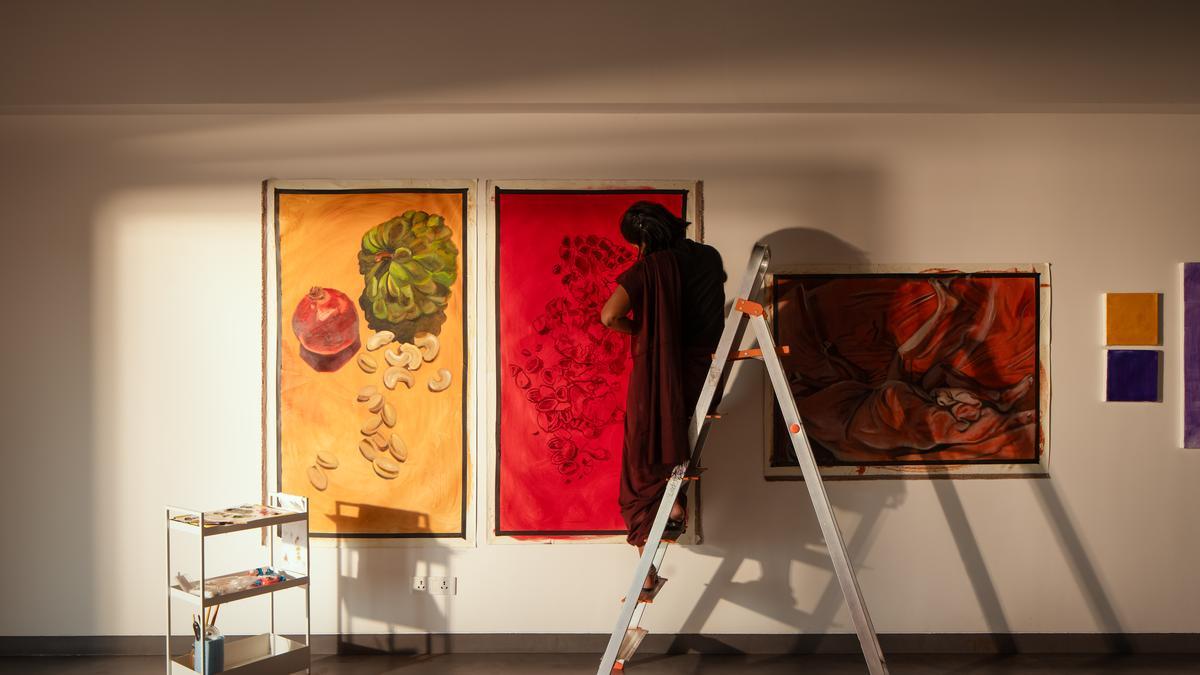
Chemould CoLab, a typically orderly gallery space located in the historic Sugra Manzil building in Colaba, transforms each summer into a bustling hub of artistic activity. Against the charming backdrop of French casement windows with glass-stained fanlights, artists immerse themselves in painting, sometimes feverishly, and at other times, with meticulous precision. When they are not engrossed in their creative processes, the artists explore Mumbai’s iconic landmarks, such as The Taj Palace and The Gateway of India, which are near the residency.
However, the inspiration for emerging artists and art practices at India’s artist residencies extends beyond the tourist spots of Mumbai. These creative sanctuaries are scattered across diverse locales — from the ancient site of Hampi and an urban village in Delhi to an artist’s family home in Bengaluru, a pastoral heritage home a few hours from Khajuraho, a factory compound in Vadodara, and a biodiversity hotspot in Kerala.
Sculptor Anirudh Shaktawat applied to the inaugural residency program of Hampi Art Labs in January, seeking a break from his packed exhibition schedule. “I explored printmaking and ceramics there, to see how these technical and costly processes could enhance my existing practice,” he explains. Hampi Art Labs, contrasting Chemould CoLab, spans a nine-acre area near the UNESCO World Heritage Site Hampi, designed by Sameep Padora and his studio sP+a, inspired by the Tungabhadra River. The residency engages artists with local communities through cultural events like pottery making, embroidery by Lambani women, and stone carving, showcasing an immersive interaction away from urban art galleries.
The residencies’ formats vary widely. While Chemould CoLab invites artists, Hampi Art Labs adopts a hybrid model, including both open calls and invitations. The inaugural residency had a mixed model, whereas subsequent sessions focused more on open calls, selecting artists through a jury process.
Chemould CoLab is intimate, hosting only up to three artists during its annual four-month residency ending in August, which promotes networking owing to its central Mumbai location. For example, Jayeeta Chatterjee drew inspiration from Mumbai’s Koli fisherwomen for her work, and Brooklyn-based artist Kuldeep Singh collaborated with local musicians, reflecting these interactions in his art.
Artist residencies across India operate with varying models. Chemould CoLab provides accommodations and meals but does not allow artists to take away their creations, culminating in an exhibition-cum-sale.
. Conversely, Hampi Art Labs and others like Khoj Art Residency Program in Delhi do not obligate artists to create or leave behind artworks. Started in 2002, Khoj Studios, placed within Delhi’s Khirki Extension, has hosted renowned artists such as Ravi Agarwal and Atul Bhalla. Pooja Sood, the curator and director of Khoj International Artist’s Association, narrates the evolution of artist residencies differing from art studios, providing an experiential and experimental space incomparable to galleries focused on sales.
Khoj has historically integrated interdisciplinary themes, mixing arts with subjects like ecology, food, fashion, gaming, and more. Delhi-based artist Asim Wakif’s experience within Khoj’s infrastructure led to significant developments in his work with bamboo, demonstrating the residency’s role in allowing experimental and sometimes uncommercial art forms.
Bengaluru’s 1ShanthiRoad, once home to its director Suresh Jayaram’s parents, also adopts a similar open yet structured approach, supporting artists with stipends provided by foundations like Sher-Gil Sundaram Art Foundation (SSAF) and partnerships with international cultural institutions. The residency building, designed by architect Meeta Jain, incorporates architectural elements reclaimed from demolition sites, offering a quaint, functional space for artists.
Contrasting models show varying accommodations and supports across residencies. While Khoj and 1ShanthiRoad maintain stipends for artists, self-funded residencies like Palette People International Art Foundation in Kerala and Art Ichol in Madhya Pradesh operate independently. Palette People, located in the biodiversity-rich Western Ghats, leads artists on explorative walks to document and create inspired by the region’s flora and fauna.
Art Ichol, nested in Madhya Pradesh’s Maihar district, shares premises with Maihar Heritage Home and Amaria Writer’s Retreat, featuring studios for diverse art forms. Director Ambika Beri remarks on the space’s accessibility, from attracted daily visitors to commissioned works for the sculpture garden, all thriving in its peak season from October to March.
In sum, artist residencies in India act as incubators for burgeoning artists, providing a platform for developing independent voices and experimental art suited to ventures beyond commercial galleries. Residencies like Khoj employ crit sessions to foster inter-generational learning, while places like Space Studio in Vadodara and Palette People extend their reach to international artists, creating a vibrant and multifaceted landscape for art across the nation. The eclectic mix of places, from cultural hubs in bustling cities to serene natural environments, highlights the dynamic and evolving terrain of artist residencies in India.










